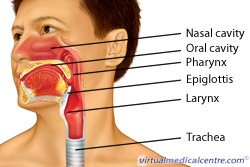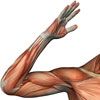- What is spasmodic dysphonia (laryngeal dystonia)?
- Statistics on spasmodic dysphonia
- Risk factors for spasmodic dysphonia
- Progression of spasmodic dysphonia
- Symptoms of spasmodic dysphonia
- Clinical examination of spasmodic dysphonia
- How is spasmodic dysphonia diagnosed?
- Prognosis of spasmodic dysphonia
- Treatment of spasmodic dysphonia
- References
What is spasmodic dysphonia (laryngeal dystonia)?

The term spasmodic describes sudden and intermittent jerking movements of muscles and, as such, SD is characterised by poor vocal motor control during speech due to intermittent and involuntary spasms of the laryngeal muscles. SD is a task-specific disorder, which means that symptoms are only experienced while performing a specific task – in this case, speech. Emotive expressions such as screaming, crying and laughing are not affected and so SD is purely a speech disorder. Speech while whispering, shouting or singing appears to be less affected by the muscle contractions, and people may use one or more of these sensory “tricks” to try to alleviate the problem (e.g. speaking with a sing-song intonation or adopting an accent).
People with SD exert significant effort and strain to speak. There are two types of SD which display markedly different vocal symptoms. Very rarely, a person may experience both forms of SD.
Adductor SD (ADSD)
ADSD involves sudden, involuntary spasmodic hyperadduction of the laryngeal muscles during vowel production, resulting in closure of the vocal cords. This causes strangled-sounding “breaks” during speech.
Abductor SD (ABSD)
ABSD involves hyperabduction of the laryngeal muscles during speech production, which results in opening of the vocal cords. ABSD is the less common form of SD. It is characterised by breathiness with aphonic whispered speech segments or breathy breaks.
Statistics on spasmodic dysphonia
SD is a rare disorder which is difficult to diagnose, and for this reason the prevalence is largely unknown. It is estimated that 1 in 100,000 people will develop the condition.
ADSD is nine times more common than ABSD. One third of all people with SD will also experience tremor of the voice, although it is possible to have vocal tremor without SD.
Women make up around 60–80% of both subtypes of people with SD. The process can occur in a wide age range, but the averageage that the condition is diagnosed is 39 years.
Risk factors for spasmodic dysphonia
Unlike other dystonias, there have been no genes identified for SD, although this may be because the condition is so rare that family studies are difficult to conduct.
SD occurs due to irregular inhibition (obstruction) of the laryngeal muscles. The mechanism for this inhibition is not clear. Post-mortem studies have determined that people with SD show decreased axonal and myelin density and increased numbers of inflammatory cells in areas of the brain that control laryngeal behaviour.
The following have not been confirmed as risk factors for SD, but have been associated with the condition at the time of diagnosis:
Major life stress;
- Upper respiratory tract infection;
- Autoimmune disorders;
- Antihistamine use; and
- Thyroid disorders.
Like other dystonias, stress and fatigue appear to make SD symptoms worse and could be a trigger for contracting the condition, but whether they are causes is still unknown.
How is spasmodic dysphonia diagnosed?
SD is a difficult condition to diagnose and is often confused with other voice disorders, which is why a number of specialists are required to make the diagnosis. Speech pathologists, neurologists and ear, nose and throat specialists work together with the information they have from their separate assessments.
Initially, the general practitioner will discuss the symptoms with their patient in order to understand the problem and then refer them to the specialist or a specialised voice clinic. After all the symptoms have been identified and discussed, a clinical and nasolaryngoscopy examination will confirm the diagnosis. Aside from these, usually no other tests are required.
Assessing the response to certain treatments will also provide an indication of whether the voice disorder is in fact SD. For example, SD does not improve with voice therapy, which can be assessed by a speech therapist. Once this has been concluded, a neurologist will test the response to botulinum toxin (BoNT; Botox) injections, as SD usually improves after this treatment.
Prognosis of spasmodic dysphonia
SD is a chronic disorder that develops suddenly and often in the third decade. Once developed, people tend to experience a gradual worsening of symptoms. If left untreated, the intensity of spasms is reduced over time in some people, indicating that eventually a change does occur in the muscles. However, very little is known in this area and it is not recommended to leave the condition untreated for this reason.
Treatment of spasmodic dysphonia

In terms of physical treatments, destroying the nerve endings (denervation) in laryngeal muscles is the most successful treatment for SD. This is most commonly achieved temporarily with botulinum toxin.
Botulinum toxin (BoNT; Botox)
BoNT injections into the adductor laryngeal muscles (thyroarytenoid) are the most effective treatment for 90% of ADSD patients. Injections can be given into one or both adductors of the vocal folds. BoNT blocks the release of acetylcholine at the neuromuscular junction, and hence reduces contractions in the injected muscles. The mechanism of action may be more complex than just producing weakness in this muscle. The procedure needs to be repeated after 3–6 months.
Different people will respond differently to the treatment. It will work better for some people than others, and some people will require repeat injections sooner than others.
Side effects associated with BoNT use for SD include breathiness, stridor, aspiration and difficulty swallowing. People with ABSD do not tend to respond as well to BoNT injections.
Surgical treatment
Surgical treatment provides permanent structural changes to the larynx, and should only be considered for people who respond well to BoNT and desire longer term management for their condition.
The aim of the procedure is to denervate the larynx to better control the muscle spasms. There is a risk of producing aphonia (an inability to speak), breathiness and swallowing difficulties after denervation. The risk of these adverse events must be weighed against the potential benefits.
Radiofrequency (RF) ablation
Radiofrequency ablation involves the use of a high frequency alternating current to destroy damaged or dysfunctional tissue. In the case of SD, the tissue destroyed is the dystonic laryngeal muscles. This is an advantageous procedure, as it is less invasive than surgery and does not require anaesthesia.
RF ablation has been found to improve scores in acoustics and voice handicap two months after the operation. RF also does not leave a scar on the neck. Some people will require further ablation or BoNT one year after RF ablation.
Article kindly reviewed by:
Associate Professor Karl Ng MB BS (Hons I) FRCP FRACP PhD CCT Clinical Neurophysiology (UK) Consultant Neurologist – Sydney North Neurology and Neurophysiology (download referral form and map); Conjoint Associate Professor – Sydney Medical School, University of Sydney; and Editorial Advisory Board Member of the Virtual Neuro Centre.
More information
 |
For more information on neurological disorders that affect movement, and their treatments, see Neurological Rehabilitation and Movement Disorders. |
References
- Blitzer A, Brin MF, Stewart CF. Botulinum toxin management of spasmodic dysphonia (laryngeal dystonia): A 12-year experience in more than 900 patients. Laryngoscope. 1998;108(10):1435-41. [Abstract]
- Ludlow C. Research priorities in spasmodic dysphonia [online]. Itasca, Illinois: National Spasmodic Dysphonia Association; 2009 [cited 14 February 2010]. Available from: URL link
- Ludlow CL. Treatment for spasmodic dysphonia: Limitations of current approaches. Curr Opin Otolaryngol Head Neck Surg. 2009;17(3):160-5. [Abstract]
- Simonyan K, Tovar-Moll F, Ostuni J, et al. Focal white matter changes in spasmodic dysphonia: A combined diffusion tensor imaging and neuropathological study. Brain. 2008;131(Pt 2):447-59. [Abstract | Full text]
- Sazgar AA, Akrami K, Akrmi S, et al. Evaluation of brainstem function in patients with spasmodic dysphonia using vestibular evoked myogenic potentials and auditory brainstem responses. Acta Otolaryngol. 2008;128(2):177-80. [Abstract]
- Brain Foundation. Spasmodic dysphonia [online]. Crows Nest, News South Wales: Brain Foundation; 2010 [cited 14 February 2010]. Available from: URL link
- Paniello RC, Barlow J, Serna JS. Longitudinal follow-up of adductor spasmodic dysphonia patients after botulinum toxin injection: quality of life results. Laryngoscope. 2008;118(3):564-8. [Abstract]
- Kim HS, Choi HS, Lim JY, et al. Radiofrequency thyroarytenoid myothermy for treatment of adductor spasmodic dysphonia: How we do it. Clin Otolaryngol. 2008;33(6):621-5. [Abstract]
- Allergan Australia. Product Information: Botox. Gordon, New South Wales: Allergan Australia Pty Ltd; 6 August 2009.
All content and media on the HealthEngine Blog is created and published online for informational purposes only. It is not intended to be a substitute for professional medical advice and should not be relied on as health or personal advice. Always seek the guidance of your doctor or other qualified health professional with any questions you may have regarding your health or a medical condition. Never disregard the advice of a medical professional, or delay in seeking it because of something you have read on this Website. If you think you may have a medical emergency, call your doctor, go to the nearest hospital emergency department, or call the emergency services immediately.

 Major life stress;
Major life stress;





